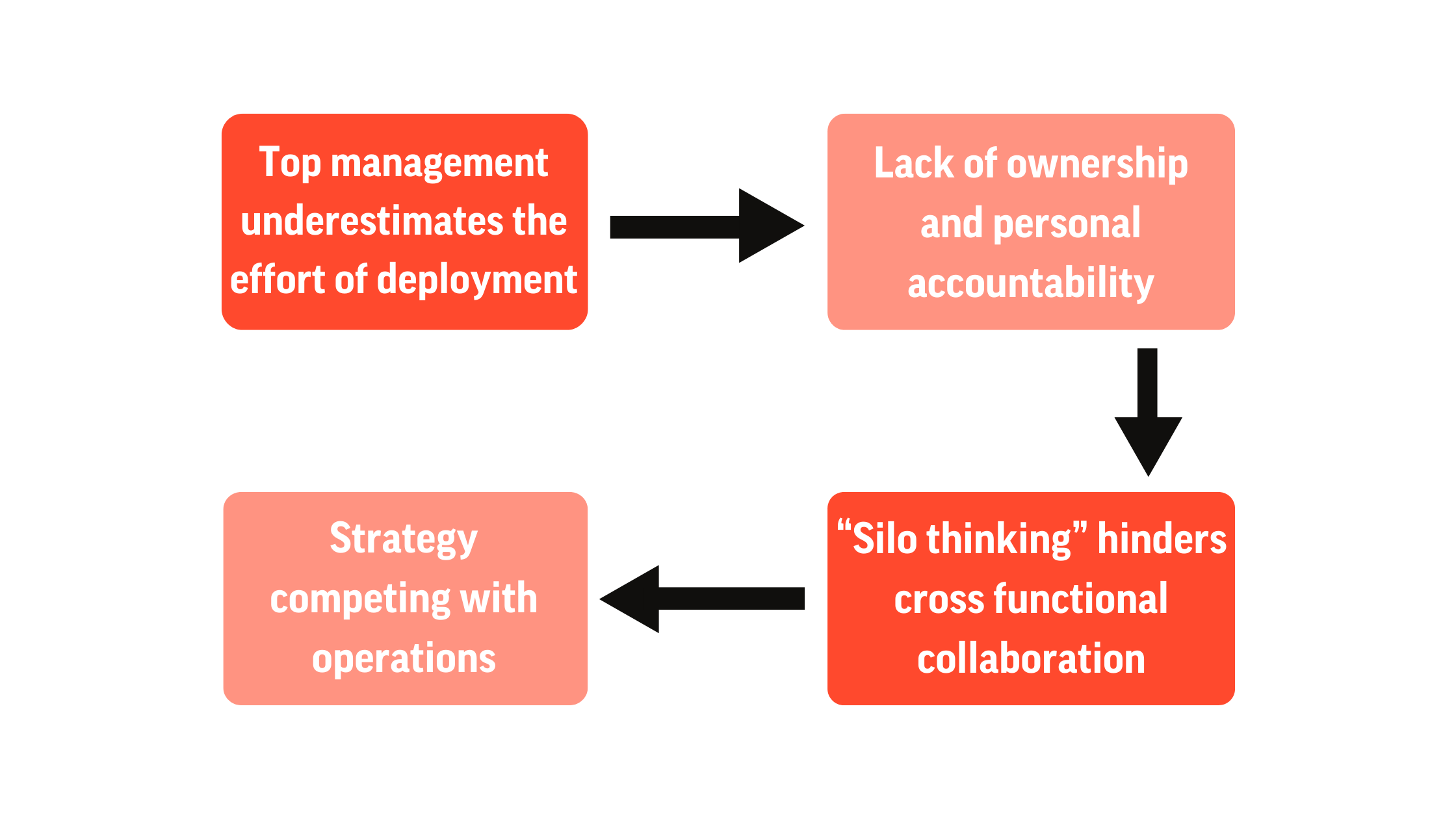OKR Framework to Strategy Execution

As consequence of accelerating change and thus increasing market uncertainty, companies across industries are looking for ways to increase the speed and flexibility of executing their strategy.
Whereas the use of Agile Principles and new ways of organizing work are improving execution capabilities, most companies are still struggling to achieve the results planned for. In fact, it has been estimated that between 40-60% of a company’s strategic potential is lost due to insufficient execution.
Using the OKR framework for strategy execution is often hailed as a solution to this challenge. OKRs have many strong holds, but like most other concepts they are no magic bullet. As research and our experience tell us, a fundamental gap between failure and success lies in creating employee ownership and accountability — and that is all about leadership.
Fill in that gap with the DecideAct tool where you can make your team accountable for their own strategic initiatives, which will contribute to the main organization strategy.
What is the OKR Framework all about?
OKRs, or objectives and key results, are fundamentally a technique for aligning on outcomes. They were made popular quite a long time ago at Intel and then at Google. They are particularly well suited for iterating on the outcomes a business is trying to drive in a quarter.
Teams set objectives and key results that align with each other and align with the company’s objectives. The objectives are a statement of intention. What is it we’re trying to accomplish? The key results cover what is success in the next 90 days. What will we have more of or less of? Typically, there are three to five objectives, each with four to five key results.
Why OKRs are powerful is because they define and give clarity to what’s most valuable to focus on and put effort into in a quarter. At the end of that 90 day period, it’s a technique that is effective at showing what we learned, what got in our way, what’s changed in the world outside, and what are the next 90 days’ outcomes that drive the highest value to the company and its customers.
The other intent with the OKR framework, which is different to what preceded them, is to emphasize what awesome looks like, as opposed to what would be safe and have the most predictable result. OKRs flip it to saying, “Okay, in the next 90 days, what is the best possible outcome we could achieve?”
What is driving the prevalence of OKRs?
A couple of things are driving the use of OKRs as a technique, and the acceleration of the operating rhythm overall in large enterprises.
Take, for example, the Covid 19 pandemic. Each quarter the world changed, from Q1 to 2 in 2020, from Q2 to 3, each of those quarters was dramatically different with new things that the organization had to face, encounter, thrive, or drive through.
Then the war in Ukraine came in Q1 2022, and we are now looking into a potential recession of the global economy as a result of these major unforeseen events. Start-ups were no longer the only companies that had to do that iteration. Every company had to iterate. So, this technique, where we align on the objectives and key results at the leadership team level, as well as across every team, is how we both iterate and mobilize quarter over quarter as the world changes and moves. That dynamic is now universal.
With the success of using OKRs in some parts of the business, like product development & commercialization, many large companies are moving to use the OKR framework for executing strategies. This is where we encounter pitfalls in the organizational deployment at a larger scale.
The pitfalls of using OKRs as a tool for strategy execution
Despite the new ambition of organizations that are already working with objectives and key results to use OKRs for strategy execution, there are gaps between the ambition and the actual results achieved. What we see as typical challenges are the following:
- Top management underestimates the effort of deployment — often, business leaders decide to deploy OKRs in the entire organization, then hire a few OKR specialists or set up a special unit and leave it to these people as change agents to deploy OKRs as a goal methodology tool trough out the organization.
A key challenge that can make the OKR framework fail is the resistance to adopting a new system at any level in the organization, the result being that leaders either a) apply OKRs in their teams out of compliance with limited engagement and follow up, or b) voluntarily take it on board, but don’t follow the basic OKR principles, such as being outcome and not activity based, or following up in a consistent way.
- Lack of ownership and personal accountability — OKRs are deployed in teams and functions, initially seen as an exciting new way of working, but over time become yet another goal management system like Balanced Scorecard or KPIs. Our most important observation from 25+ years of experience is that to get a new execution model IMPLEMENTED “just” takes compliant managers. But to REALIZE the needed results, leaders have to cultivate taking ownership and accountability throughout the organization — and that is the hard part.
- “Silo thinking” hinders cross functional collaboration – even though OKRs are intended to align goals across the organization, we often see how interdependencies between teams or people are not managed sufficiently. Surprisingly, research actually shows that only 1 out of 2 commitments are met between colleagues across functions. Hence, this is a major obstacle in using OKRs for strategy execution, and aligning goals via OKRs will in itself not make the interdependencies transparent.
- Strategy competing with operations — OKRs are promoted as a tool to focus on what matters most. Hence it is focused on driving development projects. Just like Agile, OKRs were initially created as a way for product development teams to become more outcome focused. However, a majority of an organization's time and effort are still related to running the daily operations of serving customers, externally as well as internally. When having two different models for managing development efforts and business execution, this most often will create challenges in prioritization of time spent between operations and development.
 Conclusion — what is then required to succeed?
Conclusion — what is then required to succeed?
We will argue that when executives embark on using OKRs for strategy execution, they will have to build employee ownership around the strategy as well as personal accountability for delivering results.
Having in place a shared framework like OKRs is a needed foundation, but it cannot stand alone. You will also need to build organizational discipline, and using a digital platform will be a critical enabler for ensuring consistent application of the OKR framework.
But building a sufficient sense of ownership and personal accountability amongst employees will require leaders at all levels to master the discipline of Execution Leadership.
Niels Beck and Claus Maron are founding partners of Blue Note Consultants. An advisory firm specialized in Strategy Execution and Execution Leadership and a strategic partner to DecideAct.








